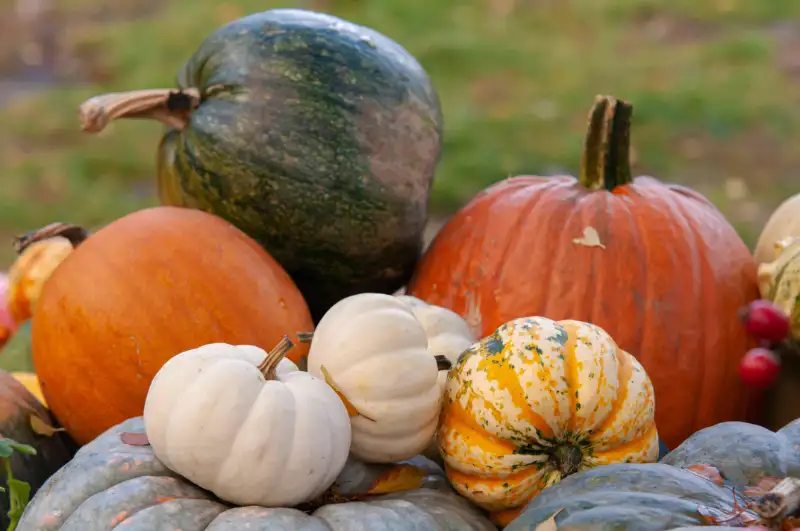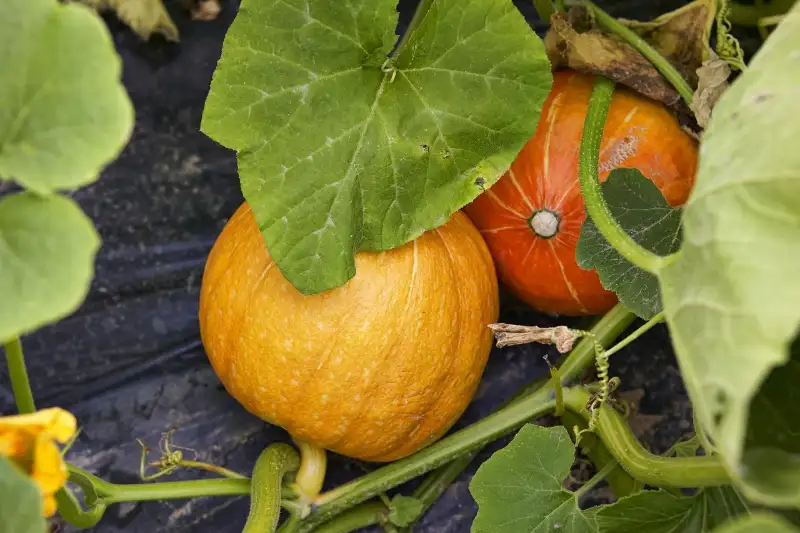Welcome to our blog on HOW MANY PUMPKINS PER PLANT! It’s a lot of work, but it’s worth it when you see your giant orange bounty.
Have you ever wondered just HOW MANY PUMPKINS you can expect from your pumpkin patch? Well, we’ve heard that if you plant enough pumpkin seeds, you could end up with a ‘patchwork quilt’ of pumpkins!
Or maybe you’re looking for Gardening TIPS on growing the MOST DELICIOUS PUMPKINS possible?
We’ve got all the answers here.
From what kind of SOIL to use to FERTILIZER TECHNIQUES and even RECIPES for pumpkin pie – we have it all covered. Well, maybe not the recipes, but you get the idea! With our EXPERT ADVICE and INSIDER KNOWLEDGE, we’ll help you get the most out of your squash patch.
So let’s get started on this spooky yet satisfying journey into the world of pumpkin farming!

Is It Easy To Grow Pumpkins?

Yes, growing PUMPKINS is relatively easy!
All you need is a SUNNY spot with good DRAINAGE and a bit of patience. Plus, an extra sprinkle of fairy dust if you’re feeling ambitious.
Plant your PUMPKIN seeds directly in the soil when the danger of frost has passed. Once they sprout, you can encourage more flowers and fruits. Do this by providing plenty of WATER and FERTILIZER. Not motivational speeches! Hahaha.
You may be surprised by how many pumpkins you end up with! Is that enough incentive for you? No? Then consider this: growing your pumpkins save you money in the long run! So why not roll up your sleeves and give it a try?
How to Increase the Number of Pumpkins a Plant Produces?

Here are some effective tips to increase the number of PUMPKINS a plant produces. And it won’t even need any magic spells!
1. Consider miniature pumpkins
Plant many miniature PUMPKIN seeds indoors or directly in your garden. This gives you more female flowers, which are responsible for producing PUMPKINS. Just like they do in Cinderella!
2. Space your pumpkins
Make sure your PLANTS have enough SPACE to produce more pumpkins. As a general rule, one pumpkin plant should be given about 4 square feet of space. That’s enough room, even for a GIANT pumpkin!
3. Consider larger pumpkins
Choose LARGER-SIZED pumpkin varieties. These tend to yield more fruit per plant than smaller and miniature varieties. KRATOS HYBRID pumpkin is an excellent example of a large variety pumpkin plant. With this one, you get up to 10 jack-o’-lanterns from a single plant!
4. Feed your plants
Provide ample SUNLIGHT and WATER throughout the growing season for maximum yields. The average pumpkin plant needs at least 6 hours of direct sunlight per day. Yep, that’s almost as much sunlight as vampires need during the day! Also, add 1 inch of water every week during the growing season.
How Many Pumpkins Per Plant?

It depends on the VARIETY of the pumpkin, the SOIL quality, and GROWING conditions. Generally speaking, one can expect between three and ten pumpkins from a single plant.
This depends on the VARIETY. This is like being asked how many children you want; some people stop at one, and others keep going!
One Dill’s Atlantic Giant pumpkin can produce up to five giant pumpkins for a single harvest. You can consider the Kratos Hybrid as a medium-variety pumpkin plant. It produces more than ten medium-sized pumpkins per plant. Now that’s what I call a magical pumpkin patch!
Do you plan to grow Jack O Lantern INDOORS or in smaller gardens? You may want to go with smaller varieties that yield just one pumpkin per plant.
For those brave souls looking for larger-sized pumpkins, consider the KRATOS HYBRID. This variety produces many more pumpkins. Though, they require much more SPACE!
What Factors Affect Pumpkin Yield?

Pumpkin yield can be affected by a variety of factors. To get the most out of your pumpkins, consider the following:
1. Planting:
Plant your pumpkins in an area with plenty of natural sunlight and good soil. Larger varieties like DILL’S ATLANTIC GIANT or KRATOS HYBRID pumpkin need more space.
MINIATURE PUMPKIN varieties, need a bit less room to stretch their legs! So, be sure to give each plant enough room to grow.
2. Temperature:
Pumpkins require warm temperatures for optimal growth. So make sure the TEMPERATURE remains between 65-85 degrees Fahrenheit. This is for while they are growing, of course!
We are not cooking them just yet, although that would make a great pie! hahaha.
3. Watering:
It’s important to WATER your pumpkins regularly during the summer months. But go easy on the water! You are not waterboarding them, after all.
Too much water cause fungal diseases that will harm your PUMPKIN plants.
Suggested reading: Water Pumpkin Properly: Detailed Guide
4. Pollination:
Pumpkins must be pollinated by bees or other pollinators to develop fruits. If there are no bees around, you can use a small paintbrush to transfer pollen.
This will be from male flowers (which have long stems) to female flowers (which have short stems). No one likes being STARVED SEXUALLY – not even vegetables!
5. Fertilizer:
Adding FERTILIZER will help keep your pumpkin plants healthy. Also, it will increase the number of large pumpkins produced per plant. Talk about getting bang for your buck!
6. Spacing:
Make sure each pumpkin has enough space by leaving plenty of room between them. This applies when planting seeds indoors or outdoors. Otherwise you will have fewer pumpkins.
It helps ensure that all of the pumpkin vines get adequate sunshine and nutrients for MAXIMUM YIELD. And who doesn’t want MAXIMUM YIELD? Certainly not us veggie lovers!
Which Variety Produces The Most Pumpkins?

When it comes to pumpkins, many varieties produce the most. Dill’s Atlantic Giant is a popular option to get a successful crop of large and giant pumpkins. After all, if you’re going to go BIG, why not go BIG?!
Which variety is the famous BUMKIN pumpkin? If you said the popular Cinderella pumpkins, then you are correct! This variety is also a great choice for small and miniature pumpkins.
Baby Boo and Jack Be Little are perfect for those looking to grow many tiny pumpkins. These can produce an average successful crop of two to five pumpkins with each plant! So what kind of pumpkin variety will you choose? With all these good harvest options available, it’s hard not to want them all!
How Much Space Does a Pumpkin Plant Require?

Want to know how much space a pumpkin plant requires? It depends on the variety of pumpkins you are growing. For example, GIANT pumpkins can require up to 25 square feet per plant.
so if you’re aiming for that world-famous bumkin pumpkin, you’d better have a lot of real estate! On the other hand, midsize varieties may only need 4 or 5 square feet.
This is great news for those with LIMITED outdoor areas. You can check the seed packet when planting for exact details. While many pumpkins may be produced in one area, it’s best to avoid overcrowding.
This reduces potential fruit size and overall yield. Normal-sized pumpkins like sugar pie and pie pumpkins grow well in 8-10 square feet.
Just give your plants proper spacing and enough male and female flowers. you’ll ensure your plants bear plenty of fruit! What will you do with your pumpkin harvest? Why not try making some things like pumpkin soup or even a fantastic homemade pumpkin pie?!
FAQs about How Many Pumpkins Per Plant
1. What happens if you plant pumpkins too close together?
Pumpkins can compete for water and nutrients if they are planted too close together. This will lead to smaller, misshapen fruits. They may also be more susceptible to disease since the air cannot circulate between them.
Additionally, overcrowding can lead to some plants becoming smothered. And growing smaller than they would with adequate space.
2. Will pumpkins choke out other plants?
No, pumpkins will not choke out other plants. Pumpkins need plenty of space to grow and spread their vines. But they will not actively over-compete with other plants in the same garden.
Instead, they can provide nutrients to the soil and attract beneficial insects. The insets can then help pollinate other nearby plants.
3. What to put under pumpkins while growing?
When growing pumpkins, you should put a layer of mulch or straw under the plants. This will help conserve moisture and keep weeds at bay. Additionally, it helps insulate the soil from extreme temperatures. Also, they protect the pumpkins from rotting on the ground while growing.
What’s Next
We started by showing you how easy it is to grow your pumpkins. Then we buttered you up. We discussed how to increase the number of pumpkin plant produce. Then, we told you the factors that affect pumpkin yield.
Next, we even covered which variety of pumpkins produces the most pumpkins. Then finalized by talking about how much space each requires.
If you want to learn more about growing pumpkins, AsterGardening is the place for you! We have the necessary tips and tricks to maximize your pumpkin yield. Our expert advice and guidance help you get the best results from your pumpkin plants.
So don’t wait – start learning now and reap the benefits of having a bountiful harvest! Get started with AsterGardening today!
